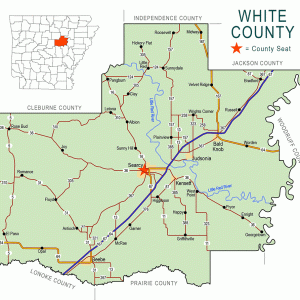calsfoundation@cals.org
Letona (White County)
| Latitude and Longitude: | 35°21’42″N 091°49’46″W |
| Elevation: | 285 feet |
| Area: | 0.39 square miles (2020 Census) |
| Population: | 240 (2020 Census) |
| Incorporation Date: | September 23, 1911 |
Historical Population as per the U.S. Census:
| 1810 | 1820 | 1830 | 1840 | 1850 | 1860 | 1870 | 1880 | 1890 | 1900 |
| – | – | – | – | – | – | – | – | – | – |
| 1910 | 1920 | 1930 | 1940 | 1950 | 1960 | 1970 | 1980 | 1990 | 2000 |
| – | 252 | 185 | 186 | 164 | 141 | 191 | 231 | 218 | 201 |
| 2010 | 2020 | ||||||||
| 255 | 240 |
Letona is a town in White County, nearly ten miles north of Searcy (White County) on Highway 310. First rising to prosperity as a stop on the Missouri and North Arkansas (M&NA) Railroad, Letona became a center of the timber industry and of agriculture, primarily fruit.
The first white settlers in White County, John and Nancy Magness, arrived in the area of what would become Letona in 1815. The area remained sparsely settled, with some farms separated by large wooded areas, throughout the nineteenth century. A Civil War skirmish, known as the Skirmish at Big Indian Creek, was fought in the area on May 27, 1862. Company A of the Thirty-second Arkansas Infantry (CS) attacked a forage train that was part of the First Missouri Infantry (US) but the men were scattered, sustaining twenty-three casualties.
Around the beginning of the twentieth century, the Doniphan Lumber Company built a lumber mill in the vicinity of what soon would become Letona. A post office was established in 1900, which at first was named Cox for postmaster Asa Cox. In the following years, a rail line was built from Seligman, Missouri, to Helena (Phillips County) on the Mississippi River. Passing through northern Arkansas, the M&NA laid rails in northern White County in 1908 and 1909. Several communities arose around the railroad depots at this time. The depot near the Doniphan Lumber Company was designated Letona, presumably for a railroad worker or executive. The name of the post office was changed to Letona in 1908. A hotel was built around 1910. The community grew rapidly and was incorporated as a town in 1911.
By 1913, the town had a population of as many as 300. The Letona Realty Company, operated by Z. M. Walker (who was also mayor of Letona) and by his sons, C. R. Walker and H. C. Walker, sold land to settlers from Iowa, Kansas, Illinois, Texas, Mississippi, Tennessee, Kentucky, and Oklahoma. Letona had more than one sawmill, as well as a cotton gin, a grist mill, a public school, and two churches—one Baptist and one Pentecostal. In addition to producing lumber, the region was already becoming known for growing peaches, strawberries, and radishes.
By 1927, the timber industry had declined, and the population of Letona had dropped to around 150. There were two grocery stores, a barber shop, and a blacksmith shop, as well as the railroad depot, post office, school, and churches. Most of the residents of Letona worked on the surrounding farms. Railroad traffic declined during the Depression but increased again during World War II. Flooding of the White River near Georgetown (White County) in April 1945 forced the closure of the line, which was never reopened in White County.
With the improvement of highways, more residents of the Letona area were able to travel to Searcy to find jobs. Consolidation closed the public school in Letona, with the community divided between the Searcy and Pangburn (White County) school districts. In the twenty-first century, Letona has two churches—Missionary Baptist and Church of Christ—as well as a volunteer fire department and a city park. The town has three structures listed on the National Register of Historic Places: the hotel, a corn crib, and the Wesley March House. The population of Letona in 2010 was 255, predominantly white.
For additional information:
Dicks, Lequeita Booker. “People Were Like Squirrels.” White County Heritage 44 (2006): 66–68.
Handley, Lawrence R. “Settlement Across Northern Arkansas as Influenced by the Missouri & North Arkansas Railroad.” Arkansas Historical Quarterly 33 (Winter 1974): 273–292.
“Prosperous Letona.” White County Heritage 19 (1981): 7.
Steven Teske
Butler Center for Arkansas Studies
 Letona, 1915
Letona, 1915  White County Map
White County Map 




I read about the town of Letona in the book Deep South by Paul Theroux. I never realised how racially segregated many towns in this part of the USA are–even more racially divided than in areas of South Africa!